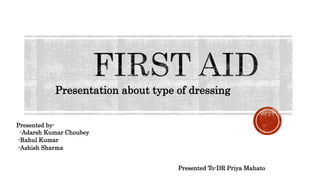This document summarizes 9 common types of wound dressings: gauze, transparent films, hydrogels, foams, hydrocolloids, calcium alginates, composites, collagen, and silicone. For each type, it provides a brief description of the material used, how it works to promote healing, and best uses for different kinds of wounds. The document was presented by Adarsh Kumar Choubey, Rahul Kumar, and Ashish Sharma to Dr. Priya Mahato.













